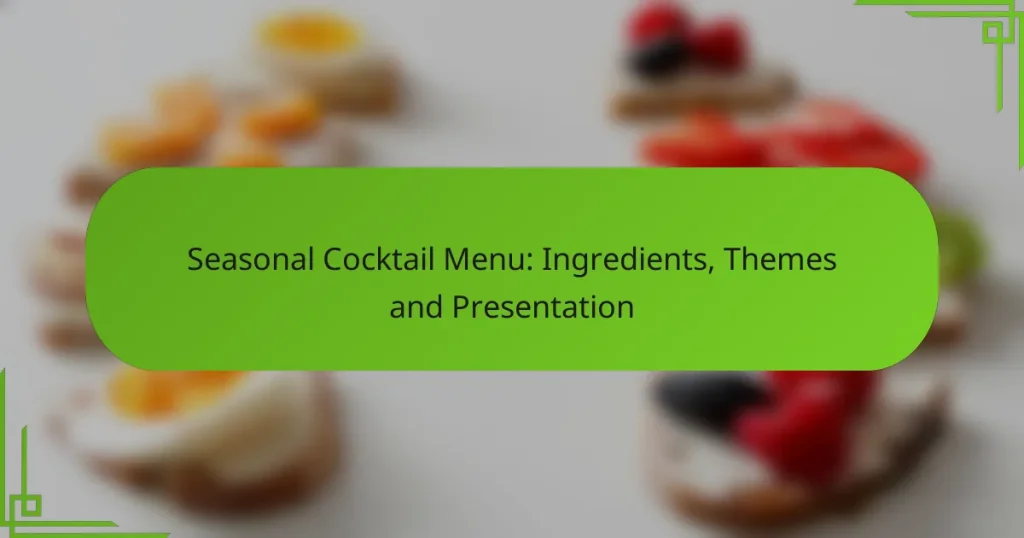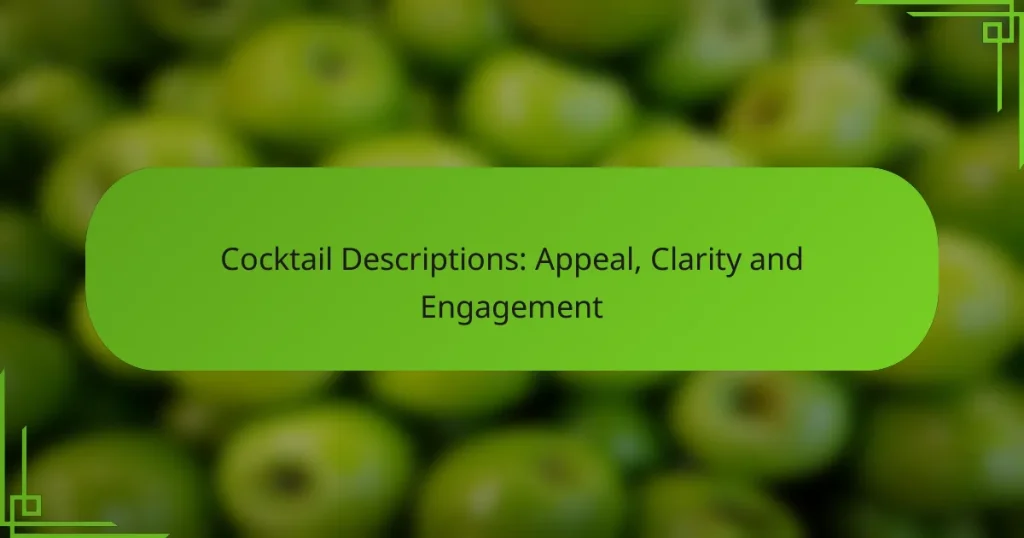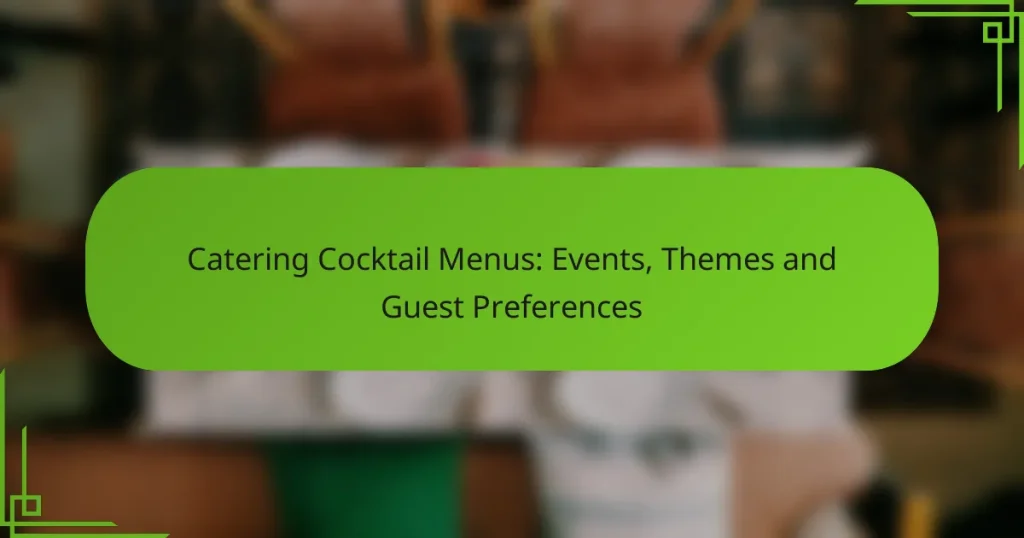Designing a creative cocktail menu in Los Angeles requires a harmonious blend of innovative flavors and local influences. By focusing on unique ingredients and thoughtful design elements, you can capture the vibrant culture of the city while enhancing the overall customer experience.
Customer Trends: Preferences, Seasonal Flavors and Popular Ingredients
Seasonal Cocktail Menu: Ingredients, Themes and Presentation
Themed vs Traditional Cocktail Menus: Which Is Better and When to Use
Menu Design: Attracting Customers and Enhancing Experience
Cocktail Descriptions: Appeal, Clarity and Engagement
Catering Cocktail Menus: Events, Themes and Guest Preferences
How to create a creative cocktail menu in Los Angeles?
Creating a creative cocktail menu in Los Angeles involves blending innovative flavors with local influences. Focus on unique ingredients and design elements that resonate with the vibrant culture of the city.
Focus on unique flavor combinations
Experimenting with unique flavor combinations is essential for a standout cocktail menu. Consider pairing unexpected ingredients, such as spicy jalapeños with sweet mango or herbal notes like basil with citrus. This approach not only excites the palate but also encourages patrons to try something new.
When crafting these combinations, aim for balance. A good rule of thumb is to incorporate one strong flavor, one mild flavor, and a complementary element to create a harmonious drink.
Incorporate local ingredients
Using local ingredients can elevate your cocktail menu and connect it to the Los Angeles community. Look for seasonal fruits, artisanal spirits, and fresh herbs sourced from nearby farmers’ markets or local distilleries. This not only supports local businesses but also enhances the freshness of your cocktails.
For example, consider using California-grown citrus like blood oranges or grapefruits, which can add a vibrant twist to classic cocktails.
Design visually appealing layouts
A visually appealing cocktail menu can attract customers and enhance their dining experience. Use a clean, organized layout with clear headings and sections that guide the reader through the offerings. Incorporate high-quality images of the cocktails to entice guests.
Consider using color schemes that reflect the ambiance of your establishment. For instance, a beach-themed bar might use ocean blues and sandy tones, while a speakeasy could opt for darker, more luxurious colors.
Use engaging descriptions
Engaging descriptions can make a cocktail menu more enticing. Instead of simply listing ingredients, tell a story about each drink. Highlight unique aspects, such as the inspiration behind the cocktail or the flavor journey it offers.
For instance, instead of “Margarita,” try “A zesty blend of fresh lime juice, organic agave nectar, and premium tequila, served with a hint of smoked salt for a twist on the classic.” This approach captures attention and encourages customers to order.
Include seasonal specials
Seasonal specials can keep your cocktail menu fresh and exciting. Introduce limited-time offerings that reflect the current season, using ingredients that are at their peak. This not only attracts repeat customers but also showcases your creativity and adaptability.
For example, during summer, consider a refreshing watermelon mojito or a spiced apple cider cocktail in the fall. Promote these specials through social media and in-house signage to generate buzz.
What are the key elements of cocktail menu design?
Key elements of cocktail menu design include structure, typography, color schemes, and imagery. These components work together to create an appealing and functional menu that enhances the customer experience and reflects the establishment’s brand.
Menu structure and organization
A well-structured cocktail menu should categorize drinks logically, making it easy for customers to navigate. Common categories include classic cocktails, house specials, and non-alcoholic options. Consider using a clear hierarchy, such as headings and subheadings, to guide patrons through the selections.
Another effective approach is to highlight signature cocktails or seasonal offerings at the top of the menu. This draws attention to unique items and can encourage customers to try something new. Ensure that the layout is visually balanced, avoiding clutter that may overwhelm the reader.
Typography and color schemes
Typography plays a crucial role in cocktail menu design, as it affects readability and sets the tone. Choose fonts that align with your brand identity; for instance, a modern bar might opt for sleek, sans-serif fonts, while a vintage-themed venue could use ornate, serif styles. Maintain consistency in font choices across headings and body text.
Color schemes should complement the overall ambiance of the establishment. Warm tones can create a cozy atmosphere, while bold colors may energize a lively space. Ensure that text contrasts well with the background for optimal readability, especially in low-light environments.
Imagery and illustrations
Imagery and illustrations can significantly enhance a cocktail menu by adding visual appeal and conveying the theme. High-quality photos of cocktails can entice customers and provide a preview of what to expect. Consider including images that showcase vibrant colors and garnishes to highlight freshness.
Illustrations can also be effective, especially if they reflect the bar’s personality. Custom artwork or icons can add a unique touch and help convey the story behind the drinks. However, be mindful not to overcrowd the menu with images; balance is key to maintaining a clean and professional look.
How to choose the right cocktail themes for your menu?
Selecting the right cocktail themes for your menu involves understanding your audience, seasonal trends, and the overall atmosphere of your venue. These elements will guide you in creating a cohesive and appealing cocktail selection that resonates with patrons.
Consider target audience preferences
Understanding your target audience is crucial when choosing cocktail themes. Consider factors such as age, lifestyle, and preferences; for instance, younger crowds may enjoy trendy, Instagram-worthy cocktails, while older patrons might prefer classic drinks. Conducting surveys or observing popular choices can provide valuable insights.
Additionally, consider regional tastes. For example, in coastal areas, tropical flavors might be more appealing, while urban settings may favor sophisticated, craft cocktails. Tailoring your menu to reflect these preferences can enhance customer satisfaction and loyalty.
Align with seasonal events
Seasonal events provide an excellent opportunity to refresh your cocktail menu. For instance, summer might call for light, refreshing drinks with fruits and herbs, while winter could inspire warm, spiced cocktails. Aligning your themes with holidays and local festivals can attract more customers looking for festive experiences.
Consider creating limited-time offerings for events like Halloween or Valentine’s Day. These themed cocktails can create excitement and encourage patrons to try something new, boosting sales during peak seasons.
Reflect the venue’s ambiance
The ambiance of your venue should heavily influence your cocktail themes. A laid-back beach bar might benefit from colorful, fruity cocktails, while a high-end restaurant may opt for elegant, sophisticated drinks. Ensure that the cocktail presentation and ingredients align with the overall vibe of your space.
Moreover, consider the décor and style of service. If your venue features rustic elements, cocktails with homemade mixers or artisanal spirits can enhance the experience. Consistency between the menu and the venue’s atmosphere will create a more memorable dining experience for guests.
What are the best practices for pricing cocktails?
Effective cocktail pricing balances profitability with customer appeal. Key practices include analyzing local market trends, factoring in ingredient costs, and considering competition pricing to establish a competitive yet profitable menu.
Analyze local market trends
Understanding local market trends is crucial for setting cocktail prices that resonate with your target audience. Research the demographics, preferences, and spending habits of your customers to tailor your offerings accordingly.
For instance, if your area has a growing interest in craft cocktails, you might price these drinks higher due to their perceived value. Utilize surveys or social media polls to gauge customer preferences and willingness to pay.
Factor in ingredient costs
Ingredient costs directly impact cocktail pricing. Calculate the total cost of each cocktail by considering both primary ingredients and any additional garnishes or mixers. Aim for a food cost percentage of around 20-30% of the selling price.
For example, if a cocktail costs $3 to make, pricing it between $10 and $15 can ensure a healthy profit margin. Regularly review supplier prices and adjust your menu accordingly to maintain profitability.
Consider competition pricing
Analyzing the pricing strategies of competitors helps position your cocktails effectively. Visit nearby bars and restaurants to compare their offerings and prices, noting any unique selling points they may have.
If competitors charge $12 for similar cocktails, consider pricing yours slightly lower or offering unique ingredients to justify a higher price. Keep an eye on seasonal changes and local events that may influence pricing dynamics in your area.
How to update a cocktail menu effectively?
To update a cocktail menu effectively, focus on customer preferences and sales performance. Regularly refreshing your offerings keeps the menu exciting and can drive increased sales.
Gather customer feedback
Collecting customer feedback is essential for understanding what patrons enjoy and what they want to see changed. Use surveys, comment cards, or social media polls to gather insights directly from your audience.
Consider incentivizing feedback with discounts or free samples to encourage participation. This approach not only provides valuable data but also engages customers, making them feel valued.
Monitor sales data
Analyzing sales data helps identify which cocktails are popular and which are underperforming. Track sales trends over time to see if certain drinks consistently sell well or if others need to be replaced.
Utilize point-of-sale systems to easily access this data. Look for patterns, such as seasonal preferences or successful promotions, to inform your menu updates.
Test new recipes before launch
Before introducing new cocktails, conduct tastings to refine recipes based on staff and customer feedback. This ensures that only the most appealing drinks make it onto the menu.
Consider hosting a soft launch or a special event to gauge customer reactions. This allows you to make adjustments based on real-time feedback and helps create buzz around the new offerings.
What tools can assist in cocktail menu design?
Several tools can significantly enhance cocktail menu design, making it both visually appealing and functional. Graphic design software, online templates, and menu design apps are popular choices that cater to various skill levels and needs.
Graphic Design Software
Graphic design software like Adobe Illustrator or Canva allows for extensive customization in cocktail menu design. These tools provide templates and design elements that can help create a unique look that reflects the bar’s theme. Users can manipulate fonts, colors, and images to ensure the menu stands out.
When using graphic design software, consider the layout carefully. A well-organized menu with clear sections for different types of cocktails can enhance readability. Aim for a balance between creativity and clarity to ensure patrons can easily find their desired drink.
Online Menu Design Templates
Online menu design templates offer a quick and easy solution for creating cocktail menus. Websites like Etsy or Template.net provide pre-designed options that can be customized with specific drink names and descriptions. This approach saves time and is ideal for those who may not have advanced design skills.
Choosing the right template is crucial. Look for designs that match the bar’s atmosphere and consider seasonal themes or special events. Ensure the template allows for easy updates, especially if the cocktail offerings change frequently.
Menu Design Apps
Menu design apps such as Menu Maker or iMenuPro are specifically tailored for creating food and drink menus. These apps often include features like drag-and-drop functionality and the ability to add images and descriptions easily. They can streamline the design process and are user-friendly for those with limited design experience.
When using menu design apps, take advantage of any built-in analytics features that track customer preferences. This data can guide future cocktail offerings and help refine the menu based on what patrons enjoy most.






